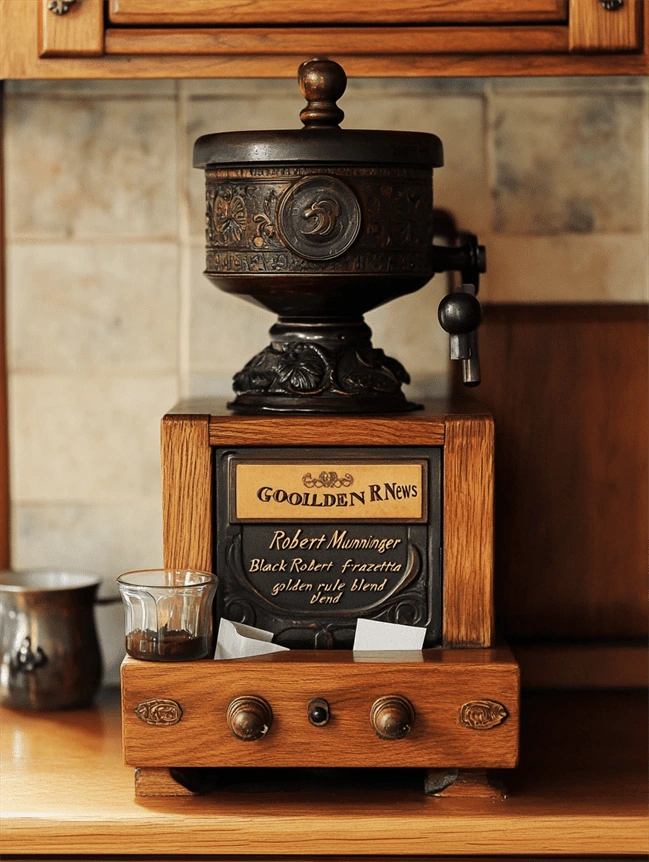Antique Coffee Grinders – Collecting and Caring for Vintage Coffee Tools
Table of Contents
Antique Coffee Grinder: A Timeless Treasure for Coffee Lovers
The art of grinding coffee dates back centuries, and an antique coffee grinder is a beautiful relic from that rich history. For coffee enthusiasts and collectors alike, antique grinders are much more than functional tools—they are windows into the past. These vintage pieces offer a tactile experience that modern electric grinders simply cannot replicate. Whether you’re seeking the charm of a vintage design, the nostalgia of an old-fashioned brewing method, or simply a way to elevate your morning routine, an antique coffee grinder adds a touch of history and character to any kitchen.

What Is an Antique Coffee Grinder?
An antique coffee grinder is a hand-operated device that was commonly used in the past to grind coffee beans into a fine powder for brewing. Unlike the electric grinders we use today, these manual grinders often have unique designs that reflect the craftsmanship and technology of the time they were made. Antique grinders can be found in various forms, including tabletop models, wall-mounted designs, and portable hand grinders. Many are made of wood, brass, or cast iron, materials that were commonly used in the 18th and 19th centuries.
What makes these grinders particularly special is their intricate mechanisms and decorative details. Some are adorned with painted wood, engraved brass plates, or ornate handles that make them not only functional but also aesthetically pleasing. Today, antique grinders are prized by collectors, decorators, and coffee lovers who appreciate their nostalgic charm and the quality of their craftsmanship.
The History Behind Antique Coffee Grinders
The origins of the coffee grinder can be traced back to the 17th century when coffee became popular in Europe. Early grinders were simple, manual tools, often consisting of two stones that were used to crush coffee beans. Over time, these rudimentary devices evolved into more sophisticated mechanisms, culminating in the hand-cranked grinders that we recognize today.
During the 19th and early 20th centuries, coffee grinders were a staple in many households. As coffee grew in popularity across Europe and North America, so did the demand for high-quality grinders. Antique grinders from this era can offer a glimpse into the evolution of coffee culture, showcasing how technology and design evolved to meet the needs of consumers.
Types of Antique Coffee Grinders
There are several different types of antique coffee grinders, each with its own distinct characteristics. Understanding the different styles can help you choose the right one for your collection or daily use.
1. Tabletop Grinders:
Tabletop grinders are the most common type of antique coffee grinder. These grinders are typically made of wood, with a metal grinding mechanism inside. They feature a crank handle on the side, which is turned to grind the coffee beans. The ground coffee is usually stored in a small drawer beneath the grinder.
Example: A classic wooden tabletop grinder with a brass grinding mechanism, often adorned with intricate designs and painted with floral patterns, is a quintessential piece of coffee history.
2. Wall-Mounted Grinders:
These grinders were once popular in kitchens where space was limited. Wall-mounted grinders feature a similar hand-cranked design but are affixed to the wall, allowing the user to grind coffee directly into a container or pot.
Example: A wall-mounted grinder with a cast-iron frame and a vintage glass jar to catch the ground coffee can evoke the feel of a traditional European kitchen from the early 20th century.
3. Portable Hand Grinders:
These small, portable grinders were popular among travelers and those on the go. They are typically compact and feature a small hand crank, making them ideal for grinding small amounts of coffee while on the move.
Example: A small, brass portable grinder with a compact design and a wooden handle was often used by soldiers or travelers who needed a practical and durable way to grind their coffee beans.
Why Collect Antique Coffee Grinders?
Collecting antique coffee grinders is a hobby that appeals to many for several reasons. For some, it’s about the craftsmanship and design; for others, it’s about the nostalgia and historical significance. Here are a few reasons why antique coffee grinders continue to captivate enthusiasts:
- Craftsmanship: Many antique coffee grinders are handmade, with intricate carvings, polished wood, and detailed brass or cast iron elements. The craftsmanship of these grinders speaks to a time when quality and attention to detail were paramount.
- Nostalgia: For coffee lovers, an antique coffee grinder evokes the memories of a simpler time, where coffee was prepared with care and effort. These grinders remind us of the ritual of making coffee by hand, a tradition that has been lost in the age of electric appliances.
- Decorative Value: Antique coffee grinders add a touch of vintage charm to any space. They can be displayed on countertops, shelves, or in a display case, bringing a sense of warmth and history to your home.
- Functional Use: While many collectors display their antique grinders as decorative pieces, some still use them for grinding coffee beans. The manual grinding process offers a unique, slow-brewed experience that many coffee aficionados find enjoyable.
How to Care for an Antique Coffee Grinder
Caring for an antique coffee grinder is essential to preserving its value and functionality. Here are a few tips to keep your grinder in excellent condition:
- Regular Cleaning: To maintain the performance of the grinder, clean it regularly. Use a small brush to remove coffee grounds from the grinding mechanism and a damp cloth to wipe down the exterior. Avoid soaking the grinder in water, especially if it’s made of wood, as this can cause warping.
- Lubrication: Some antique grinders have moving parts that require occasional lubrication. Apply a small amount of food-safe oil to the crank mechanism to keep it turning smoothly.
- Avoid Overuse: If you’re using the grinder for coffee, avoid grinding too many beans at once. Overuse can wear down the grinding mechanism and reduce the longevity of the grinder.
Conclusion
An antique coffee grinder is more than just a tool—it’s a connection to the past, a work of art, and a piece of history. Whether you’re an avid collector, a coffee enthusiast, or someone who appreciates vintage décor, owning an antique coffee grinder offers a chance to experience the craftsmanship and design of a bygone era. With proper care, these grinders can serve both as functional kitchen tools and as cherished keepsakes for generations to come.

